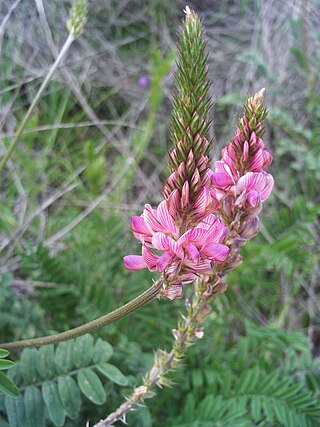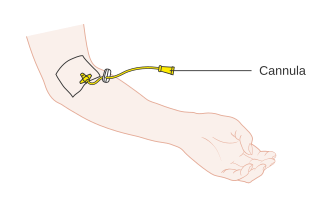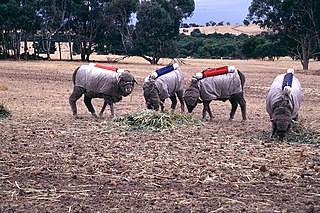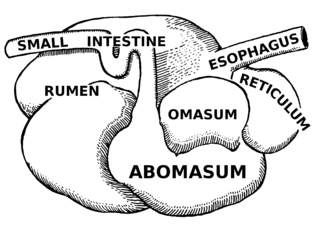Ruminal tympany, also known as ruminal bloat, is a disease of ruminant animals, characterized by an excessive volume of gas in the rumen. Ruminal tympany may be primary, known as frothy bloat, or secondary, known as free-gas bloat. [1]
In the rumen, food eaten by the ruminant is fermented by microbes. This fermentation process continually produces gas, the majority of which is expelled from the rumen by eructation (burping). [2] Ruminal tympany occurs when this gas becomes trapped in the rumen.
In frothy bloat (primary ruminal tympany), the gas produced by fermentation is trapped within the fermenting material in the rumen, causing a build up of foam which cannot be released by burping. [3] In cattle, the disease may be triggered after an animal eats a large amount of easily fermenting plants, such as legumes, alfalfa, red clover, or white clover. [1] Some legumes, such as sainfoin, birdsfoot trefoil and cicer milkvetch are not associated with causing bloat in cattle. [4] In feedlot cattle, a diet containing a high proportion of cereal grain can lead to primary ruminal tympany. [5] The main signs of bloat in cattle are distension of the left side of the abdomen, dyspnea (difficulty breathing) and severe distress. If gas continues to accumulate, the right side of the abdomen may also become distended, with death occurring in cattle within 3–4 hours after symptoms begin. [1]
In free-gas bloat (secondary ruminal tympany), gas builds up in the rumen and cannot escape, due to blockage of the esophagus. [1]

Onobrychis viciifolia, also known as O. sativa or common sainfoin was an important forage legume in temperate regions until the 1950s. During the Green Revolution it was replaced by high yielding alfalfa and clover species. Due to its anthelmintic properties, common sainfoin is a natural alternative to drugs to control nematode parasitism in the guts of small ruminants. This is the main reason why O. viciifolia returned to the scientific agenda in recent years.

Ruminants are herbivorous grazing or browsing artiodactyls belonging to the suborder Ruminantia that are able to acquire nutrients from plant-based food by fermenting it in a specialized stomach prior to digestion, principally through microbial actions. The process, which takes place in the front part of the digestive system and therefore is called foregut fermentation, typically requires the fermented ingesta to be regurgitated and chewed again. The process of rechewing the cud to further break down plant matter and stimulate digestion is called rumination. The word "ruminant" comes from the Latin ruminare, which means "to chew over again".

Lactic acidosis refers to the process leading to the production of lactate by anaerobic metabolism. It increases hydrogen ion concentration tending to the state of acidemia or low pH. The result can be detected with high levels of lactate and low levels of bicarbonate. This is usually considered the result of illness but also results from strenuous exercise. The effect on pH is moderated by the presence of respiratory compensation.

A cannula is a tube that can be inserted into the body, often for the delivery or removal of fluid or for the gathering of samples. In simple terms, a cannula can surround the inner or outer surfaces of a trocar needle thus extending the effective needle length by at least half the length of the original needle. Its size mainly ranges from 14 to 26 gauge. Different-sized cannula have different colours as coded.
There are different systems of feeding cattle in animal husbandry. For pastured animals, grass is usually the forage that composes the majority of their diet. In turn, this grass-fed approach is known for producing meat with distinct flavor profiles. Cattle reared in feedlots are fed hay supplemented with grain, soy and other ingredients to increase the energy density of the feed. The debate is whether cattle should be raised on fodder primarily composed of grass or a concentrate. The issue is complicated by the political interests and confusion between labels such as "free range", "organic", or "natural". Cattle raised on a primarily foraged diet are termed grass-fed or pasture-raised; for example meat or milk may be called grass-fed beef or pasture-raised dairy. The term "pasture-raised" can lead to confusion with the term "free range", which does not describe exactly what the animals eat.
Abdominal bloating is a short-term disease that affects the gastrointestinal tract. Bloating is generally characterized by an excess buildup of gas, air or fluids in the stomach. A person may have feelings of tightness, pressure or fullness in the stomach; it may or may not be accompanied by a visibly distended abdomen. Bloating can affect anyone of any age range and is usually self-diagnosed, in most cases does not require serious medical attention or treatment. Although this term is usually used interchangeably with abdominal distension, these symptoms probably have different pathophysiological processes, which are not fully understood.
The rumen, also known as a paunch, is the largest stomach compartment in ruminants and the larger part of the reticulorumen, which is the first chamber in the alimentary canal of ruminant animals. The rumen's microbial favoring environment allows it to serve as the primary site for microbial fermentation of ingested feed. The smaller part of the reticulorumen is the reticulum, which is fully continuous with the rumen, but differs from it with regard to the texture of its lining. It covers approximately 80% of total ruminant stomach portion
Streptococcus bovis is a group of strains of Gram-positive bacteria, originally described as a species, that in humans is associated with urinary tract infections, endocarditis, sepsis, and colorectal cancer. S. bovis is commonly found in the alimentary tract of cattle, sheep, and other ruminants, and may cause ruminal acidosis. It is also associated with spontaneous bacterial peritonitis, a frequent complication occurring in patients affected by cirrhosis. Equivalence with Streptococcus equinus has been contested.

Enteric fermentation is a digestive process by which carbohydrates are broken down by microorganisms into simple molecules for absorption into the bloodstream of an animal. Because of human agricultural reliance in many parts of the world on animals which digest by enteric fermentation, it is the second largest anthropogenic factor for the increase in methane emissions directly after fossil fuel use.

Polioencephalomalacia (PEM), also referred to as cerebrocortical necrosis (CCN), is a neurological disease seen in ruminants that is caused by multiple factors, one of which is thiamine depletion in the body. Thiamine is a key chemical in glucose metabolism that, when deficient, is most threatening to neurological activity. In addition to altered thiamine status, an association with high sulfur intake has been observed as a potential cause of PEM. PEM may also be caused by other toxic or metabolic diseases such as: acute lead poisoning or salt poisoning. Cattle, sheep, goat, and other ruminants that are diagnosed with PEM or pre-PEM suffer opisthotonus, cortical blindness, disoriented movement, and eventually fatality, if left untreated. Current data shows that the onset of PEM can range from birth to late adulthood.

A trocar is a medical or veterinary device used in minimally invasive surgery. Trocars are typically made up of an awl, a cannula and often a seal. Some trocars also include a valve mechanism to allow for insufflation. Trocars are designed for placement through the chest and abdominal walls during thoracoscopic and laparoscopic surgery, and each trocar functions as a portal for the subsequent insertion of other endoscopic instruments such as grasper, scissors, stapler, electrocautery, suction tip, etc. — hence the more commonly used colloquial jargon "port". Trocars also allow passive evacuation of excess gas or fluid from organs within the body.
Fog fever is a refeeding syndrome in cattle, clinically named acute bovine pulmonary emphysema and edema (ABPEE) and bovine atypical interstitial pneumonia. This veterinary disease in adult cattle follows an abrupt move from feedlot to 'foggage pasture'. Clinical signs begin within 1 to 14 days and death may follow within 2 to 4 days. The condition can affect up to 50% of the herd, and around 30% of affected cattle may die as a result. This metabolic nutritional-respiratory disturbance has also been reported in other ruminants and on a wide variety of grasses, alfalfa, rape, kale, and turnip tops.
Abomasitis is a relatively rare ruminant disease characterized by inflammation of abomasum usually caused by larval development in young calves, lambs, and goat kids. It occurs with gastroenteritis, but can also be a side effect of other diseases. However, it is seldom diagnosed as a separate condition.
Erle E. Bartley was an Agricultural Science Professor at Kansas State University from 1949 until his death in 1983. He was known for his many agricultural inventions, especially those regarding ruminal tympany problems. He invented the bloat preventative poloxalene, also known as "Bloat Guard".

Cattle are large, domesticated, bovid ungulates widely kept as livestock. They are prominent modern members of the subfamily Bovinae and the most widespread species of the genus Bos. Mature female cattle are called cows and mature male cattle are bulls. Young female cattle are called heifers, young male cattle are oxen or bullocks, and castrated male cattle are known as steers.

Asparagopsis taxiformis, formerly A. sanfordiana, is a species of red algae, with cosmopolitan distribution in tropical to warm temperate waters. Researchers have demonstrated that feeding ruminants a diet containing 0.2% A. taxiformis seaweed reduced their methane emissions by nearly 99 percent.
Karen Beauchemin is a federal scientist in Canada who is recognized as an international authority on methane emissions and ruminant nutrition. Her research helps develop farming techniques that improve how we raise cattle for meat and milk, while reducing the environmental impacts of livestock production.
Methanogens are a group of microorganisms that produce methane as a byproduct of their metabolism. They play an important role in the digestive system of ruminants. The digestive tract of ruminants contains four major parts: rumen, reticulum, omasum and abomasum. The food with saliva first passes to the rumen for breaking into smaller particles and then moves to the reticulum, where the food is broken into further smaller particles. Any indigestible particles are sent back to the rumen for rechewing. The majority of anaerobic microbes assisting the cellulose breakdown occupy the rumen and initiate the fermentation process. The animal absorbs the fatty acids, vitamins and nutrient content on passing the partially digested food from the rumen to the omasum. This decreases the pH level and initiates the release of enzymes for further breakdown of the food which later passes to the abomasum to absorb remaining nutrients before excretion. This process takes about 9–12 hours.

Displaced abomasum in cattle occurs when the abomasum, also known as the true stomach, which typically resides on the floor of the abdomen, fills with gas and rises to the top of the abdomen, where it is said to be ‘displaced’. When the abomasum moves from its normal position it prevents the natural passage of gas and feed through the digestive system, creating a restriction. As cattle are ruminants, which have a 4 chambered stomach composed of a rumen, reticulum, omasum and abomasum. Ruminants require this specialized digestive system in order to properly process and break down their high fiber and cellulose rich diets. As this type of digestive system is quite complex it is at a greater risk for incidence. Due to the natural anatomy of cattle it is more common to have the abomasum displace to the left, known as a left-displaced abomasum, than to the right, right-displaced abomasum. When the abomasum becomes displaced there also becomes a chance of an abomasal volvulus, twist, developing. An abomasal volvulus occurs when the abomasum, which is already out of place, will rotate and cut off blood and nutrient supply to the abomasum. Cattle which develop an abomasal twist require immediate vet attention to regain blood supply and food passage through the digestive system or the abomasum will begin to shut down due to lack of blood supply and toxicity development.

FutureFeed was established by Australia's Commonwealth Scientific and Industrial Research Organisation (CSIRO) for seaweed as a ruminant livestock feed ingredient that can reduce methane emissions by 80% or more. FutureFeed holds the global intellectual property to use Asparagopsis for livestock feed. Lowered methane emissions can be achieved by the addition of a small amount of the seaweed into the daily diet of livestock. This discovery was made by a team of scientists from CSIRO and James Cook University (JCU), supported by Meat & Livestock Australia (MLA), who came together in 2013 to investigate the methane reduction potential of various native Australian seaweeds.